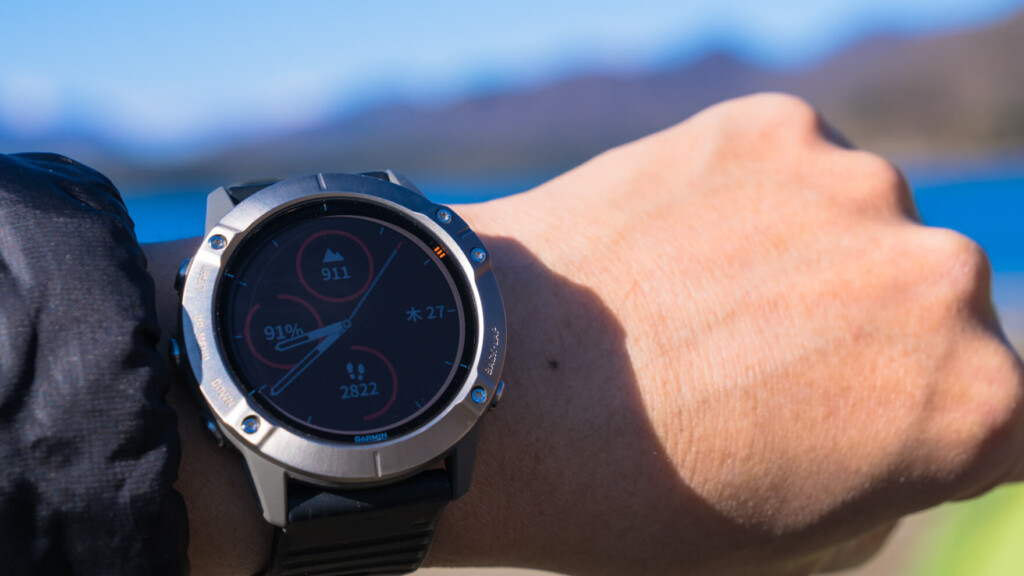
Review: Garmin Fenix 6X Pro Dual Power I've been waiting for this. Outdoor smartwatch that satisfies the desires of all athletes and weekend adventurers
It's been over three months since I bought the Garmin fenix 6X Pro Dual Power , an outdoor smartwatch that's well-performed for enthusiastic athletes and all the features to enjoy a variety of activities.
The Fenix 6 series is Garmin 's flagship smartwatch, and is the legitimate successor to the Fenix 5 Plus This latest release appears to have had several welcome evolutions, including a slimmer and lighter body, longer and more efficient battery life, and a finely improved interface. Above all, it is also a memorable model that is the first solar charging function installed in the company's smartwatch. Is it time to finally break away from the battery life issues that have been lingering on smartwatches? I couldn't stop being excited when I picked it up.
This time, I would like to report on what Garmin 's latest and best-in-class outdoor smartwatches, the Fenix 5X, MARQ EXPEDITION , Suunto 9, Suunto Ambit , and CASIO WSD-F30, and what I felt after actually using them for mountain climbing, trail running, and running for about three months, and what I could do with this watch and how it actually feels to use them.
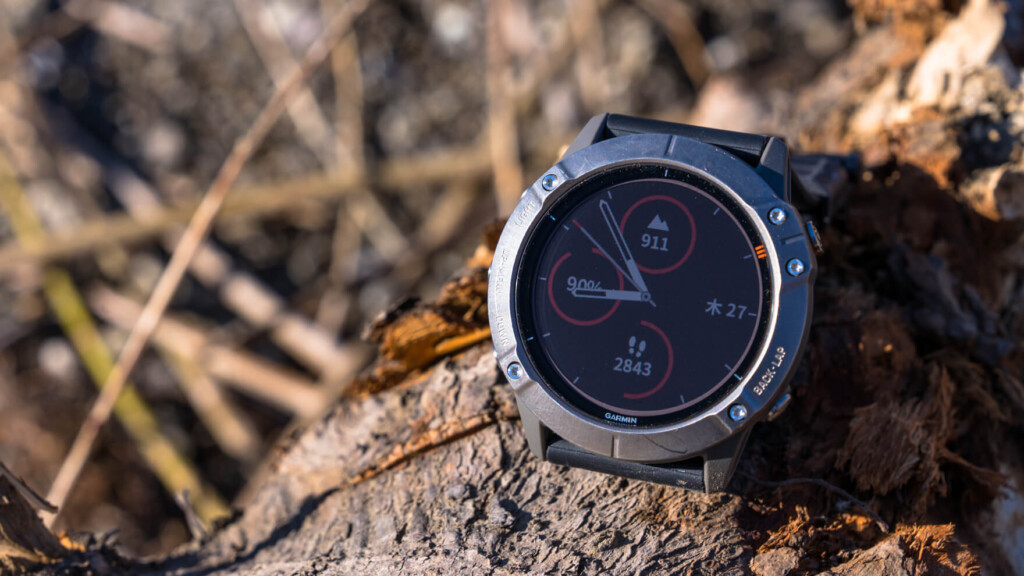
table of contents
Fenix 6X Pro Dual Power has evolved from the Fenix 5x plus series
In the previous model of Garmin's Fenix 5x plus series, the only changes from the previous model were updated to focus mainly on smart features, such as music players, Garmin Pay, and preload maps in all lineups. On the other hand, the Fenix 6 series has seen major progress, though gradually, overall, with lighter and more compact, larger screens (Fenix 6X Pro), and longer battery life.
What's changed with Fenix 5x plus from Fenix 6X Pro Dual Power (excerpt)
- Lighter weight (88 g → 82 g for the same titanium model)
- Thinner (17.5mm → 14.9mm)
- Instead of reducing the bezel, the screen size has been enlarged (1.2 inches in diameter 240 x 240 pixels → 1.4 inches in diameter 280 x 280 pixels)
- The lens material has been changed from sapphire lenses to "Power Glass (Material: Gorilla Glass)" (6X is a traditional sapphire lens). *Is this compatible with solar charging rather than evolution?
- Added solar charging function.
- The battery life has been significantly increased. For example, the usual "GPS + optical heart rate monitor" can last up to 30 hours → 60 hours + solar charge.
- New battery management features (customizing finer features on and off to adjust the battery life balance to your liking).
- New Expedition Mode (can be tracked for up to 36 days by disabling all functions other than reduced rate GPS tracking).
- Added ultra-saving battery mode (so that basic watch functions alone can provide up to 80 days of battery life).
- A new PacePro function (so that you can calculate the pace expansion in advance for your target time, so that you can run while checking the progress of the game).
- The internal memory has doubled, reaching 32 GB (the number of music titles that can be saved from up to 500 songs to 2,000).
- Added map display theme (high contrast, popular, dark).
- Allows you to display three widget display interfaces at once.
The appearance doesn't seem to be much different, but in reality, there are only a few changes to the list. Personally, I think it's more welcome than anything else, as it has been made compact and larger on the hardware side, and more than anything, the fact that the battery life has been significantly increased.
Comparison table of previous model and Fenix 6X Pro Dual Power
For reference, if we roughly compare the specs of the SUUNTO 9 BARO, which is considered a competitor, with the hardware specifications, it seems that although the screen size and clarity are inferior (the SUUNTO 9 is a touch panel), it is a good match in terms of thickness and battery life. This depends on how you use it, so it's not very meaningful to compare just the highest numerical part.
| Item name | fēnix 5X Plus Sapphire Black | Fenix 6X Pro Dual Power Ti Black DLC | SUUNTO 9 BARO Black (Reference) |
|---|---|---|---|
| Reference price (excluding tax) | 109,800 yen | 130,000 yen | 85,800 yen |
| weight | Sapphire Black: 96 g (Sapphire Ti Black: 88 g) | 82 g | 81 g |
| Body size | 51 x 51 x 17.5 mm | 51 x 51 x 14.9 mm | 50 x 50 x 16.8 mm |
| Screen size | Diameter 1.2 inch (30.5 mm) | Diameter 1.4 inch (35.56 mm) | |
| resolution | 240 x 240 pixels | 280 x 280 pixels | 320 x 300 pixels |
| Lens material | Sapphire lenses | Power Glass (Material: Gorilla Glass) | Sapphire crystal |
| Bezel material | DLC stainless steel | Diamond-like carbon (DLC) coated titanium | Stainless steel |
| Case material | FRP | FRP | Made of glass fiber reinforced polyamide |
| Strap material | silicon | silicon | silicon |
| battery | Watch Mode: Up to 18 Days GPS + Optical Heart Rate Monitor: Up to 30 Hours GPS + Music Playback + Optical Heart Rate Monitor: Up to 11 Hours UltraTrac™ Mode + Optical Heart Rate Monitor: Up to 64 Hours | Smartwatch mode: Up to 24 days / week*1 GPS + Optical heart rate monitor: Up to 60 hours + 6 hours*2 GPS + Music playback: Up to 16 hours + 1 hour*2 UltraTrac mode: Up to 70 hours + 10 hours*2 Expedition mode: Up to 36 days + 6 days*2 Battery-saving watch mode: Up to 64 days + 26 days*2 | In Time Mode: 14 days 24 hours a day tracking and mobile notifications: 7 days Training modes using GPS: |
| Internal Memory/History | 16GB | 32GB | - |
| Offline color map | Shobunsha topographic map/road map | Shobunsha topographic map/road map | - |
*1: If exposed to 50,000 lux light for 3 hours outdoors every day for a week, it can be charged in a total of approximately 24 hours (smartwatch mode).
*2: When used under conditions of 50,000 lux
Which Fenix 6 series should you choose?
Before we begin our detailed review, for those considering purchasing, let's take a look at some of the differences between them on the different lineups of the Fenix 6 series.
Confusingly, there are fewer models in regular distribution in Japan than the lineup that are available overseas, so simply the name alone often doesn't support functionally compared to the Fenix 5, so be careful.
Fenix 6 Series
This is the basic model of the Fenix 6. The cheapest models didn't have music storage, preloaded topographic maps, and Wi-Fi connectivity, which were the Fenix 5 Plus. You can choose from Corning Gorilla Glass 3 or Sapphire Crystal lenses, and models equipped with sapphire crystal lenses come with music storage and Wi-Fi connection function.
Fenix 6S Series
Slightly compact. Instead of the case size of 42mm, the battery life is slightly shorter than the Fenix 6. And again, the cheapest models don't have music storage, preloaded topographic maps, or Wi-Fi connectivity, and you can choose from Corning Gorilla Glass 3 and Sapphire Crystal lenses for lenses, and models equipped with sapphire Crystal lenses come with music storage and Wi-Fi connectivity.
Fenix 6X Series
This is a legitimate evolution model with a significantly higher price point, which has been upgraded overall from the Fenix 5 Plus. It also comes with music storage, offline topographic maps, and Wi-Fi connection functions. And the differences between the 6 and 6S include an overwhelmingly long battery life and PacePro racing strategy function.
Fenix 6X Pro Dual Power Series
Finally, the most high-end model I will be reviewing this time is the 6X Pro Dual Power. This model features a 6X with an ultra-lightweight all-titanium body and adds solar charging function. Furthermore, this model allows you to select a titanium band as an option.
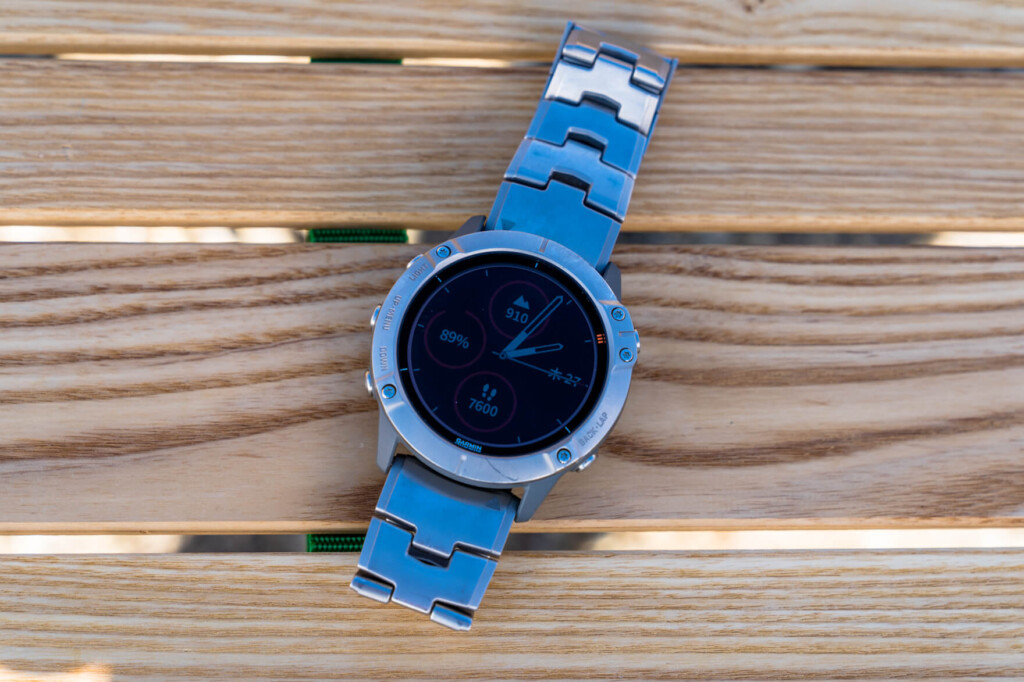
The high-end model Fenix 6X Pro Dual Power offers a titanium band model. It doesn't look strange even when you try it in everyday business situations.
| Item name | Fenix 6 | Fenix 6S | Fenix 6X Sapphire | Fenix 6X Pro Dual Power |
|---|---|---|---|---|
| Base model reference price (excluding tax) | 70,000 yen | 65,000 yen | 110,000 yen | 130,000 yen |
| weight | 80 g | 58 g | 93 g | 82 g |
| Body size | 47 x 47 x 14.7 mm | 42 x 42 x 13.8 mm | 51 x 51 x 14.9 mm | 51 x 51 x 14.9 mm |
| resolution | 260 x 260 pixels | 240 x 240 pixels | 280 x 280 pixels | 280 x 280 pixels |
| Bezel material | Stainless steel | Stainless steel | Diamond-like carbon (DLC) coated stainless steel | Diamond-like carbon (DLC) coated titanium |
| battery | Smartwatch Mode: Up to 13 days GPS + Optical Heart Rate Monitor: Up to 36 hours UltraTrac Mode: Up to 42 hours Expedition Mode: Up to 22 days Battery Saving Watch Mode: Up to 38 days | Smartwatch Mode: Up to 9 Days GPS + Optical Heart Rate Monitor: Up to 25 Hours UltraTrac Mode: Up to 30 Hours Expedition Mode: Up to 16 Days Battery Saving Watch Mode: Up to 27 Days | Smartwatch Mode: Up to 21 days | Smartwatch Mode: Up to 24 days / 1 |
| Internal Memory/History | 64 MB | 64 MB | 32 GB | 32 GB |
| Preloaded topographic map | - | - | Shobunsha topographic map/road map | Shobunsha topographic map/road map |
| Music Storage | * Models equipped with sapphire crystal lenses include up to 2,000 songs. | * Models equipped with sapphire crystal lenses include up to 2,000 songs. | Up to 2000 songs | Up to 2000 songs |
| Wi-Fi connection function | *Included with models equipped with sapphire crystal lenses. | *Included with models equipped with sapphire crystal lenses. | can be | can be |
| PacePro Features | - | - | can be | can be |
| Solar charging | - | - | - | can be |
Looking at it this way, if you prioritize lightweight, compact, and affordable prices, the 6 or 6S, but it's quite poor in terms of functionality and durability. Even though it's the Fenix6 series, when it comes to the lowest-class model, performance on the hardware such as lenses has deteriorated, and in the same price range, some people may think that the company's ForeAthlete 945, which has offline maps and music storage, is a more functional bargain. To be honest, if you're focusing on road-based sports and exercises such as running and triathlon, and if you're thinking about cost-effectiveness, I might recommend ForeAthlete over the Fenix series.
Conversely, if you enjoy a variety of sports and outdoor activities and want to use it thoroughly in races, you will need to be prepared for a considerable amount of money, but unless you choose a model with sufficient hardware and functionality, such as the 6X or 6X Pro Dual Power, you will not be able to experience the benefits of the Fenix 6.
First impressions (design and interface)
Now, let's finally move on to reviewing the Fenix 6X Pro Dual Power usage.
Appearance: Following the previous model
The looks are basically the same as the Fenix 5 Plus. The back of the plastic case is covered with a metal plate and edged with a titanium bezel with a more durable DLC coating. The overall diameter of the watch remains the same, but the narrower bezel width has increased the display area.
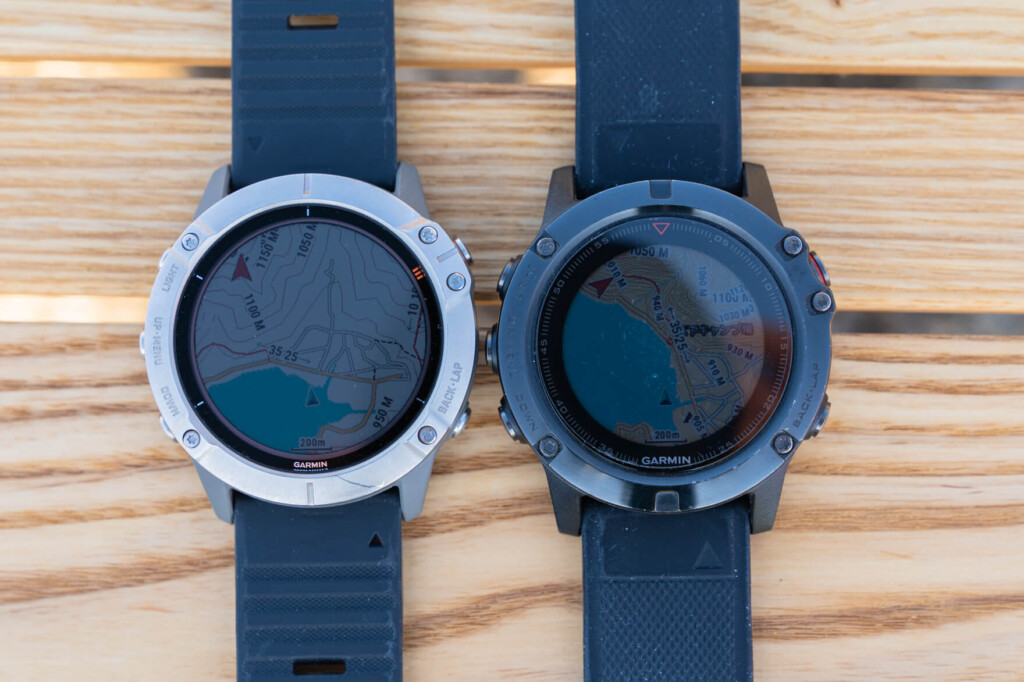
Screen comparison of Fenix 6 Pro Dual Power (left) and Fenix 5x (right). At a glance, the thinner bezel has expanded the display area of the screen.
Furthermore, the body thickness (despite the extended battery life) is slightly thinner from 17.5 mm to 14.9 mm. I'm particularly happy about the catch when carrying my backpack, which is extremely stressful.

It may be confusing, but the bottom bulge on the Fenix 6 Pro Dual Power (left) is slightly thinner.
The band is familiar and compatible with QuickFit® watch bands, making it easy to change according to your preference. Personally, I think that if you can use a DLC titanium band for everyday wear and a silicone strap for training or field, it will perfectly satisfy your daily needs.
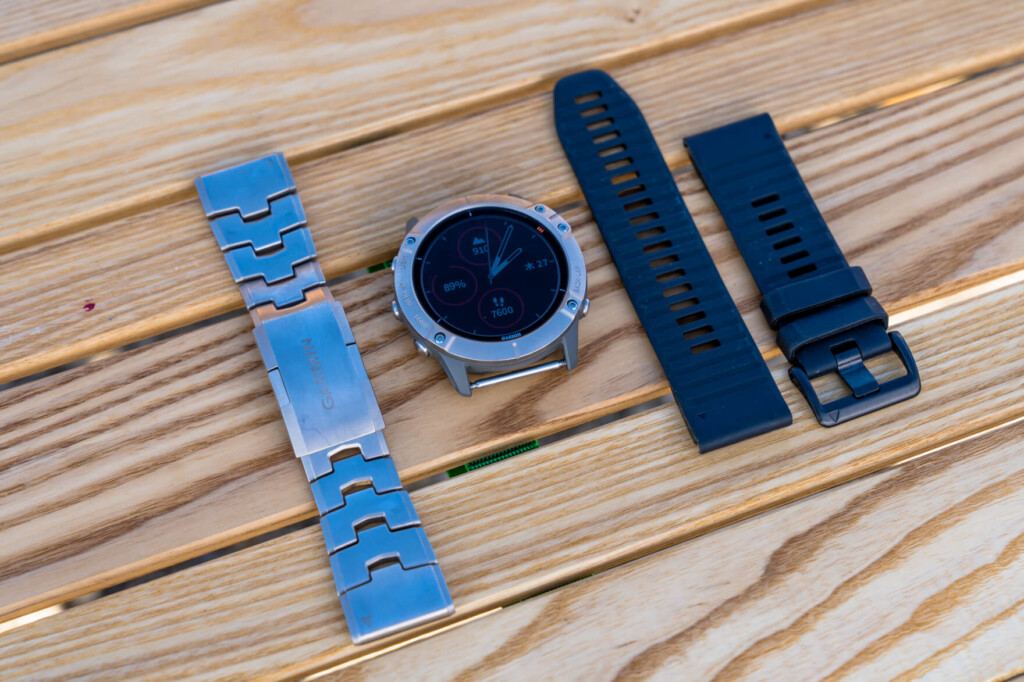
Easy to remove band. The titanium band model comes with a silicon band as standard (but the color is orange, not black in the photo).
Display: Ensures high visibility while minimizing battery consumption
The 1.4-inch display, which has an increased size by 36% compared to the Fenix 5 Plus, features tempered glass solar charging lenses. The wider 280 x 280 pixels makes the map easier to see, and of course, it's only good.
On the other hand, the display used in Garmin's Fenix series is a semi-transparent memory-in-pixel (MIP) display, just like before. Compared to other outdoor smartwatches, it is not a convenient touchscreen or a high-definition, highly visible organic EL device, so it is not a bit unpleasant. To be honest, once you get used to looking at organic EL displays, you can't deny the impression that it's quite dark. Incidentally, there is no ambient light sensor, so it does not automatically adjust the brightness.
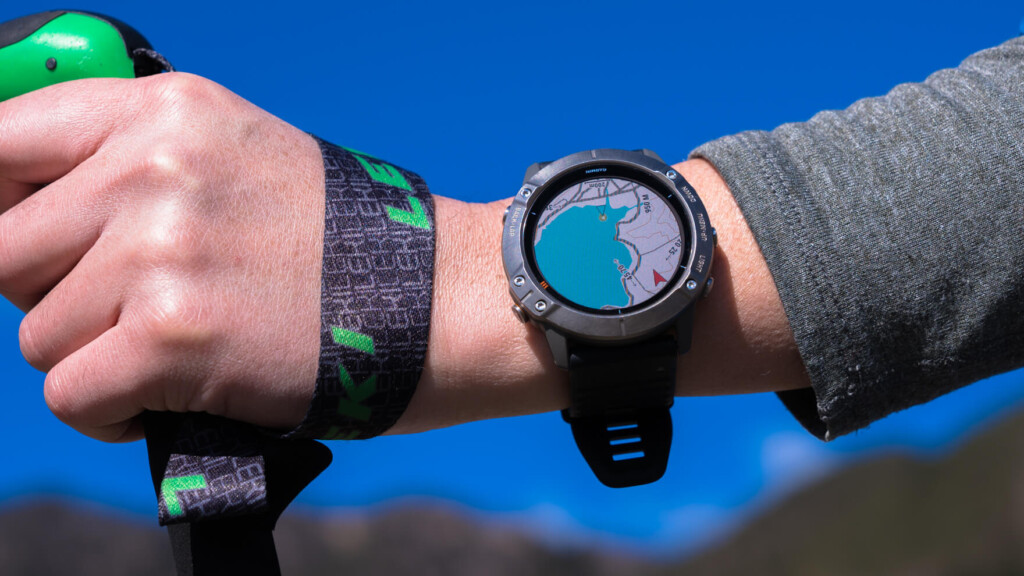
The visibility of the screen display is undeniable as it is as usual Garmin-like (rough). However, it's not that it's difficult to see even under the sun, so it's not particularly stressful.
The positive side is that it is extremely energy efficient. It is certainly true that visibility is difficult to lose even in direct sunlight or in dark places, and this is a trade-off with battery life, so we have no choice but to give up.
Button configuration: Button operation requires familiarity
All Fenix 6 series are operated with six easy-to-press buttons. Since you cannot operate with a touch panel, you will still need to learn complicated operation methods. There are very few settings that can be completed by simply pressing the button a few times. In addition to the adjustment itself, it requires more than 10 clicks, such as adjusting the display brightness. To be honest, I still have to say it's stressful.
Also, it's not a bad thing that the buttons are protruding so easily they're easy to push, but if you're not careful, you may end up stuck when you put on and take off your backpack and accidentally push them. On the other hand, you can definitely push it even if you wear gloves in winter, and while listening to music, you could easily and reliably play it and operate it to the next song even if the watch was hidden under the sleeves or gloves, so this can be solved to a certain extent due to individual differences and familiarity issues.
Durability: Passing points
Titanium case, tempered glass, 10 atm water resistance, and operating temperature range of -20℃ to +45℃ is very suitable for water sports and snowy mountains.
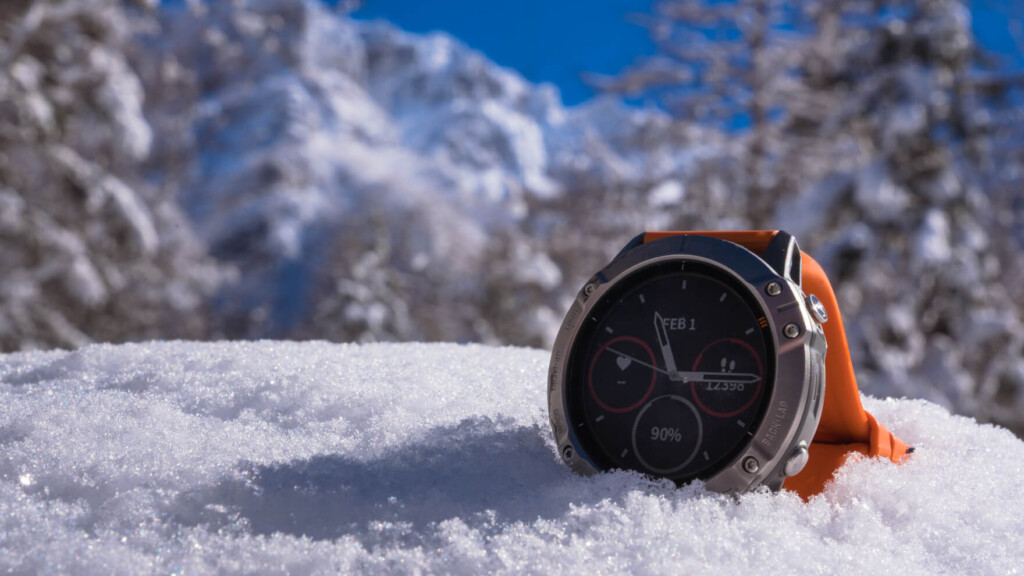
What can you do (features and technology)
In recent years, high-end outdoor smartwatches have expanded the possibilities explosively through not only basic ABC (compass, pressure, altitude) functions, but also a wealth of sensors such as GPS, heart rate monitors, gyros, acceleration, thermometers, and data such as color maps and music storage, as well as devices such as smartphones.
This makes watches that simply require checking numbers, and now they're more efficient in training, better results in races, safer adventures, and more convenient in everyday life.
What can we do at the cutting edge of multisport smartwatches? For now, I'll excerpt the parts that seem to be relevant to me, and roughly list the features (however, the following is not a joke, but only about half of what I can do).
- In addition to the basic functions of the clock, it can also display and record statistics on a wide range of health information, including ABC (compass, pressure, altitude), temperature data, as well as heart rate, steps, stress level, sleep duration and sleep quality.
- The GPS sensor and pre-installed color topographic map allow you to display your current location on the map even in areas that are not connected to the Internet.
- You can track and record a variety of activities, including hiking and mountain climbing, trail runs, running, triathlon, exercise, cycling, swim, water sports, slope skiing, and backcountry skiing. During this time, you can record and display performance information such as speed, elapsed time, altitude, heart rate, calories burned, training effects, and VO2Max values using various sensors.
- Using the map and compass function, you can register a route and navigate to your destination using arrows, sounds, vibrations, etc.
- Various data measured with Garmin devices will automatically analyze and a virtual coach on your smartphone will present you with a training menu.
- The PacePro pacing function will guide you on race and training running courses at a pace adjusted to suit your level.
- In addition to USB charging, it also has solar charging function.
- It can be used continuously for up to 24 days in smartwatch mode, up to 60 hours (+ solar charge) in modes using GPS and heart rate monitors, and up to 36 days (+ solar charge) using GPS alone.
- With "Power Management", you can set the battery saving mode or the power mode that efficiently consumes the battery to your liking, selecting only the functions you want to use.
- You can connect to your smartphone via Bluetooth to receive weather information, calendar schedules, smartphone notifications and incoming phone calls, and explore lost mobile devices.
- It can be connected to an inReach device and sent simple messages and SOS signals from the watch.
- You can use the Garmin Connect app to save and view activity history and detailed analysis, life logs such as activity level and sleep, and set and operate clocks and various apps.
- You can use the Garmin Connect IQ app to add and set up watch faces and apps provided by Garmin and third parties.
- During some activities, you can detect accidents during some activities and send a message to an emergency contact.
- You can play and control the music from your paired smartphone or downloaded to your watch (up to 2,000 songs) from the watch.
- Garmin Pay allows you to make contactless payments at compatible merchants.
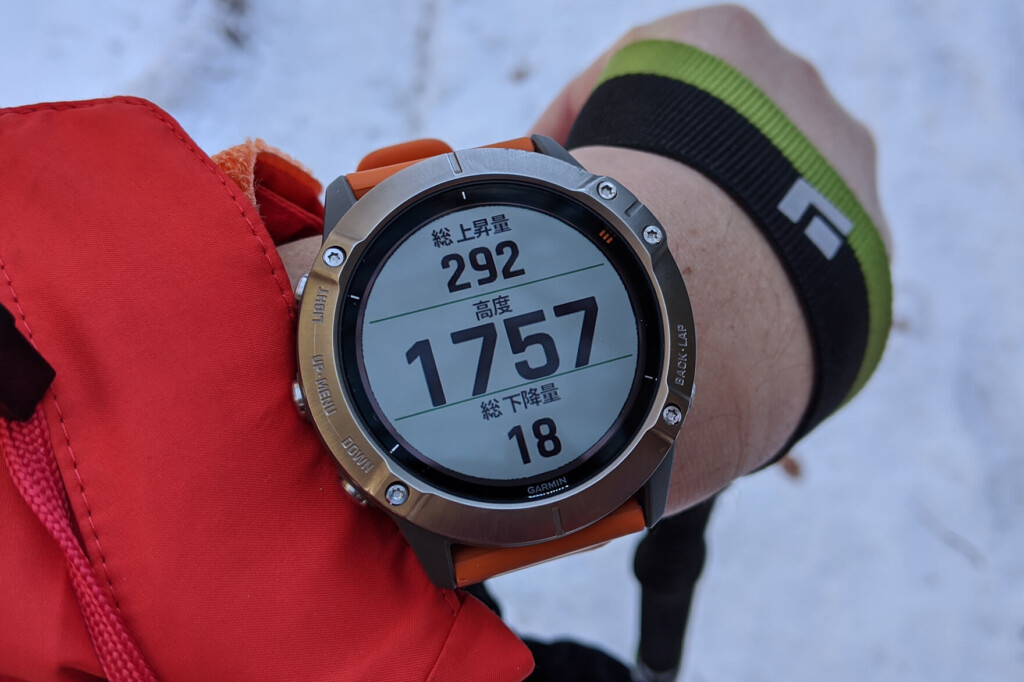
Try using it in mountain climbing, running, skiing, and backcountry
We will introduce how it feels to use after actually using it for the past three months. Just like with other smartwatches, in order to use it, you must first install the smartphone app Garmin Connect Mobile and pair it with your smartphone.
Once the initial setup is complete, you can use it in the field immediately, but if you want a little more customization, you can add your own watch face from the Garmin Connect IQ app or set up a widget that implements additional features on the watch.
You can add a wide variety of functions than you might imagine, from those that provide simple information such as temperature, sunrise and sunset, to those that display fitness information in an easy-to-view format, to those that are easy to read for specific purposes, such as maps and navigation systems, music players, entertainment, calendars, and weather forecasts that make everyday life more convenient.
By installing these, you can quickly customize to your own specifications even if you can only use the minimum functionality at first, and you will be able to quickly access the information you want using the button on the left. I have the following minimum widgets included, but there are so many other widgets that I can't choose.
- Solar
- weather
- Sunrise & Sunset
- ABC (altitude, pressure, orientation)
- Performance (VO2 MAX values from last training and predicted time for 5kg, 10kg, half, full marathon)
- Overview of previous activities
- Number of steps
- Health information statistics (heart rate, stress values, etc.)
- calendar
- notification
- Music

By adding a widget, you can easily access information on the display screen, just like in the photo.
Activity tracking with mountain climbing, running and backcountry skiing
Try using the Fenix 6X Pro Dual Power for mountain climbing and hiking. To be honest, this is almost the same functionally as the previous model.
No matter which activity you are, you basically just press the button on the top right, then select the activity and start. By the way, if you save course data in advance on your clock, you can also use the "navigation" function, which allows you to navigate the route while walking (running).
The data that can be viewed in real time during tracking is pre-set depending on the activity, but once you get used to it, you can arrange it as you like. For example mountain climbing , the items that are set first are for each screen.
- Total rise/altar/total fall
- Distance/Rise
- Current location (latitude)
- Heart rate
- Current location (map)
- Current time and battery level
is.
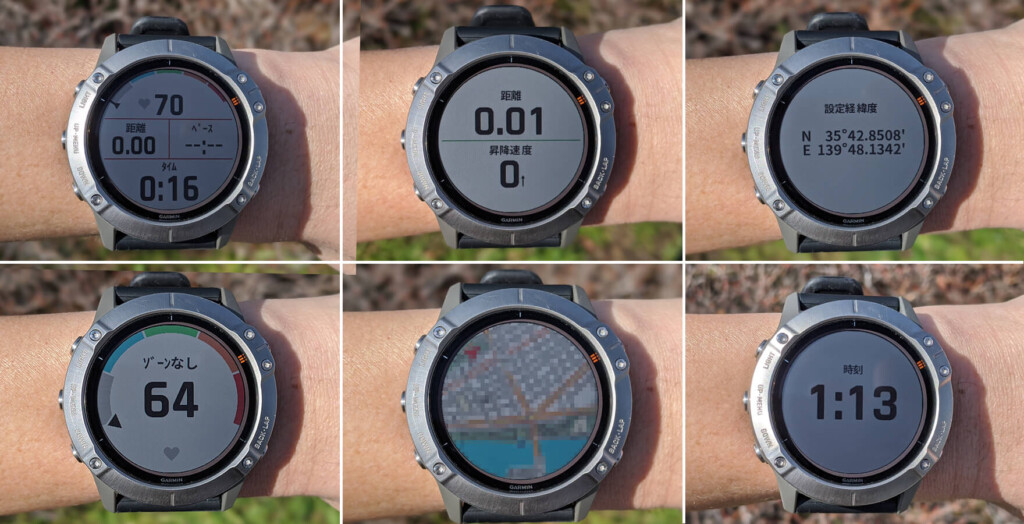
However, I can easily arrange the information I want to check immediately while I'm taking action, such as replacing the "Current Location (Latitude)" screen with the "Atmospheric Pressure & Calories Burned" screen, and then adding the "Compass" screen. This is a bit troublesome at first, but once you set it up, it's really comfortable.
Incidentally, trail run items are:
- Heart rate/distance/time/pace
- Heart rate/Total rise/Time/Rise speed
- Heart rate/lap distance/lap time/lap pace
- Current time
- Current location (map)
is.

However, to make this easier for me, I replaced the second "Time" with "altitude" and the "rise and lowering speed" with "total descent," and added screens for "straight length", "pitch", and "speed".
backcountry skiing , hiking and skiing are automatically recognized, and the display is made according to the time.
- Distance/Living speed (maximum speed when sliding)/Time
- Time/Time/Sunday time/Heart rate
- Set latitude/direction of travel/altitude
- Current location (map)
- Last time hiking up (or skiing)
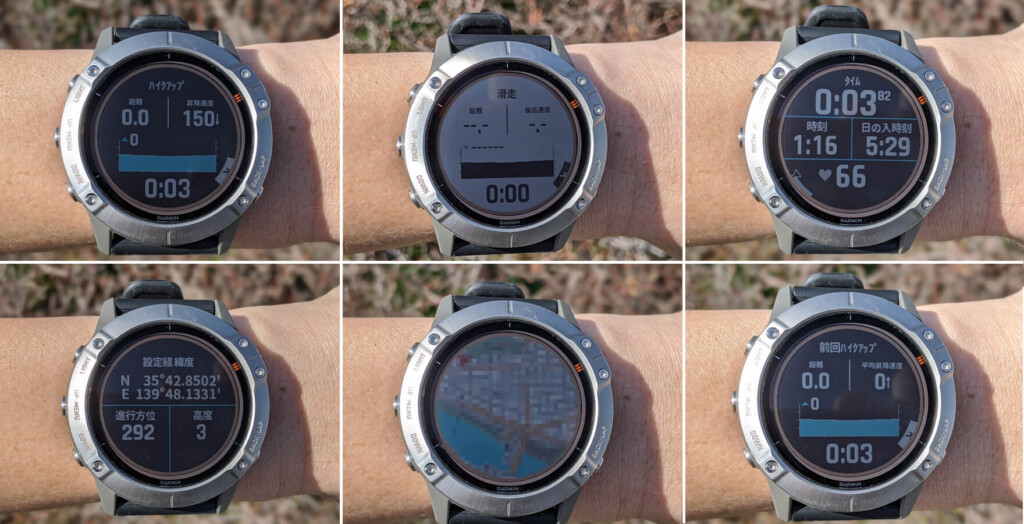
A reasonable battery life
The battery life this time is really amazing and has been lasting better. Since I started using this watch at the end of the year, I have been using it in a smartwatch mode (100% backlight) that connects to fitness tracking such as normal heart rate and steps without doing any activity (100% backlight) and even after being left on for more than two weeks, the battery still remains at 30% or more. Moreover, at this time, the watch was hidden under the long sleeves, so solar charging was almost not performed. The nominal "up to 24 days" figure does not seem to be much of an error.
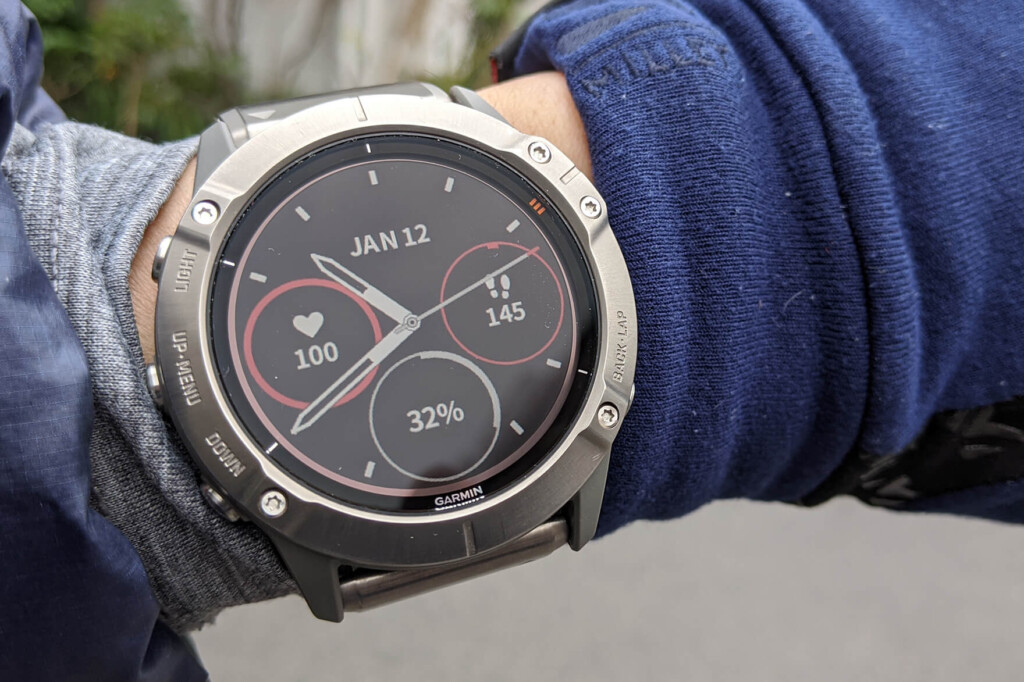
After about two weeks since the end of the year, the battery still lasted a few days.
Next, let's talk about how long the battery lasts during activities. Without setting the savings, I tried measuring it several times using normal activity tracking.
For backcountry skiing for around 3 hours and approximately 5km, it is in the low 80% range, and only consumes around 10%. It also lasted around 70% after using it for about 6 hours, and even after tracking for nearly 15 hours, it remained at over 50%.
Of course, if you dim the backlight from here, consumption can be further reduced, and if you turn it into UltraTrac mode, you will be able to acquire GPS and various sensor data less frequently, which will last more than twice that time. Also, in "Expedition mode", the GPS acquisition function only has a low power consumption, making it possible to use it without charging for up to a month. As you can see, if you only have one activity, you can say that there is almost no need to worry about the battery running out just because it's a smartwatch.
The solar charging function is still a relief
This solar charging function is a must-have for you. Officially, solar-charged lenses can extend battery life for up to 24 hours in smartwatch mode when exposed to at least three hours of sunlight per day, similar to that of sunny winter weather.
The widget allows you to display solar charging activity for the past 6 hours, so I spent about half a day with my watch exposed and saw how much the battery was running out. By the way, there is no activity tracking and it is in smartwatch mode.
In reality, I realized that while I was charging this solar, the battery level continued to not increase or decrease. Personally, although solar charging is not effective enough to "actively charge", it seems to be effective to "maintain the current status" of the battery.
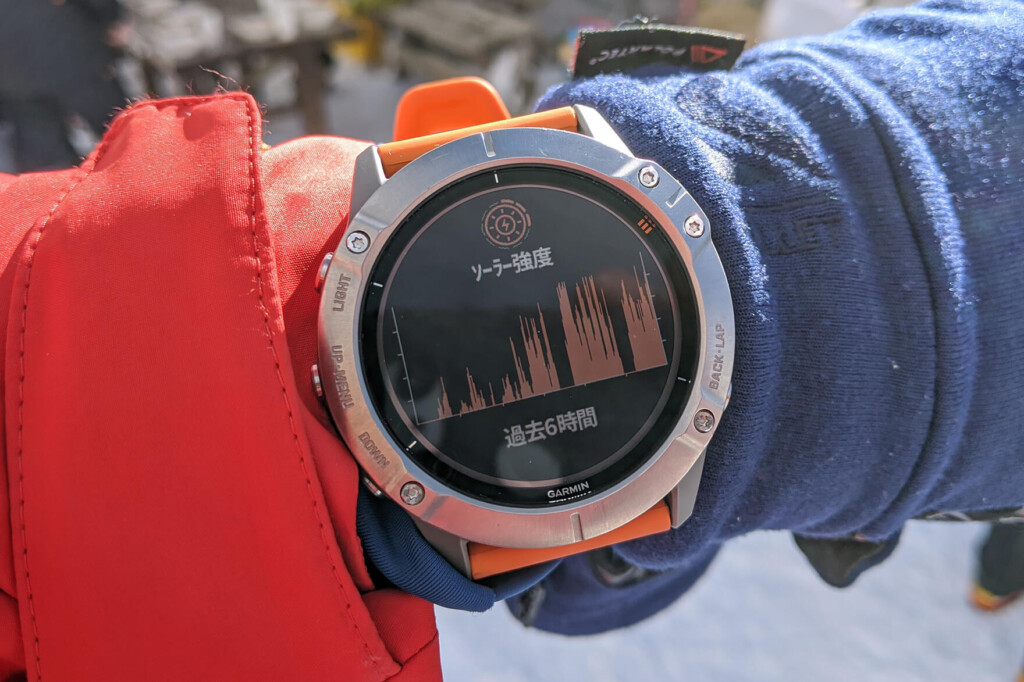
When I spent time with solar charging working, the battery level was not reduced or increased, and it remained at the same level forever.
Map display: A little progress?
The map-related software is the Fenix 5X Plus , so the impression of its ease of viewing and use remains large. It can be recalled and viewed during normal or active activities. During the activity, your current location and the path you have walked so far will be displayed on the map. The current position speed and accuracy combined with GPS, GLONASS, Galileo and Michibiki are decent.
A slightly improved point is that the screen size has increased by about 17% from "240 x 240 pixels" to "280 x 280 pixels", allowing you to understand the route without any stress (photo above).
In addition, the map display has now allowed you to choose from several themes, such as "high contrast" which increases visibility by increasing contrast, and "dark" which increases visibility at night, which also made the map seem to be easier to see to some extent.
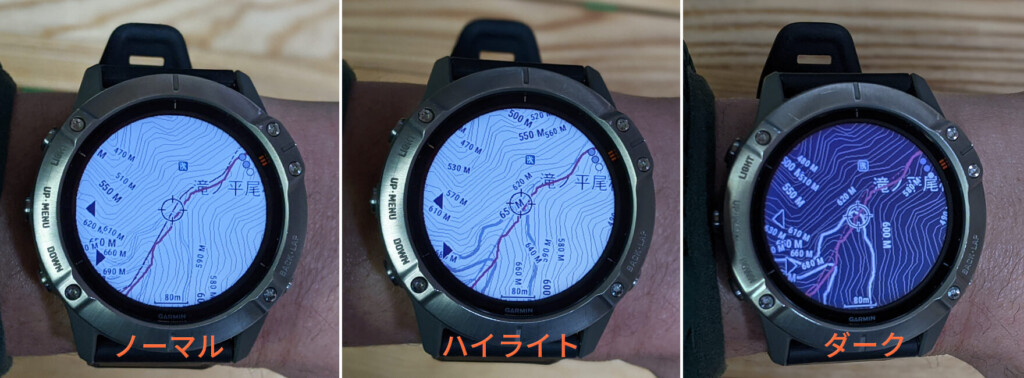
Furthermore, compared to smartphone maps and touch screen smartwatches, it is clearly inconvenient to use buttons to zoom in and move the screen. For this reason, it is not recommended to replace a map using this alone, and at a practical level it is merely checking your current location and surrounding topography. Of course, even if you don't, you should always carry a paper map with you in case of the worst.
It's scary! Course planning function with Pace Pro
Using the course strategy planning function by Pace Pro, one of the new features added in the Fenix 6x, it instantly determines the optimal pace allocation for running at a time you have set a route. The settings can be made using GARMIN CONNECT on your smartphone or PC.
For example, in the diagram below, if you were to run through a 7km course around Okutama's Bonoori Mountain in about an hour, Garmin Connect also calculated the altitude difference and came up with a plan for pace every 1km. Moreover, from here on, you can adjust whether you want to run with a tendency to increase the pace of the first half (positive), or to keep the pace down in the first half (negative), making it surprisingly easy to create your own ideal race plan. I think it's overspec for me, but it's scary.

With the Pacepro function, you can instantly analyze any course and create a race plan.
Analyze past activities thoroughly with Garmin Connect
Once the activity is finished, the activity will be saved and connected to your smartphone and immediately transferred to the Garmin Connect app, allowing you to look back on it with just as detailed data as possible.
In case of mountain climbing (data recorded in MARQ reviews repost)
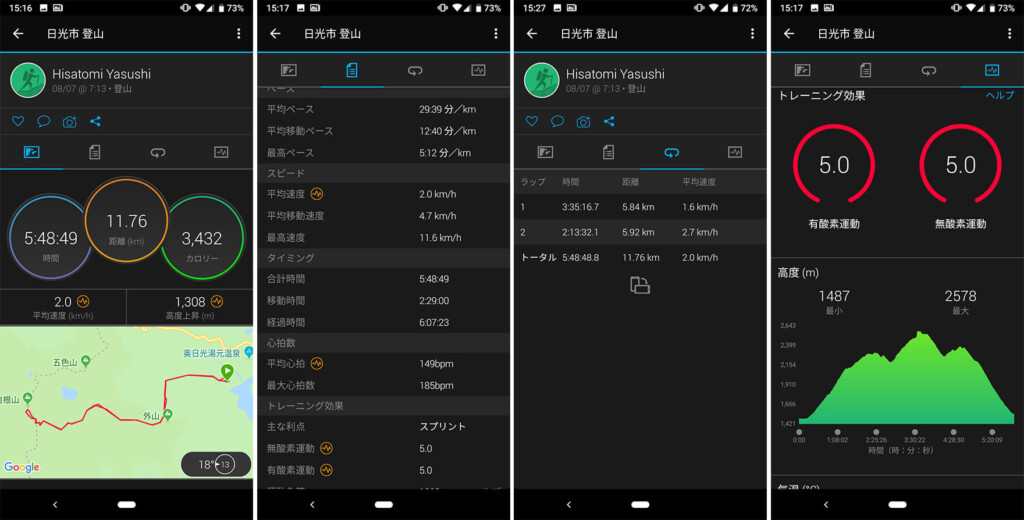
A record of your actions when setting up a "Mountain Climbing" activity. In any case, you can instantly check the multifaceted, detailed data on your smartphone immediately after it is finished.
In the case of backcountry
For backcountry activities, hike up and down are automatically sorted and color-coded to display the data.
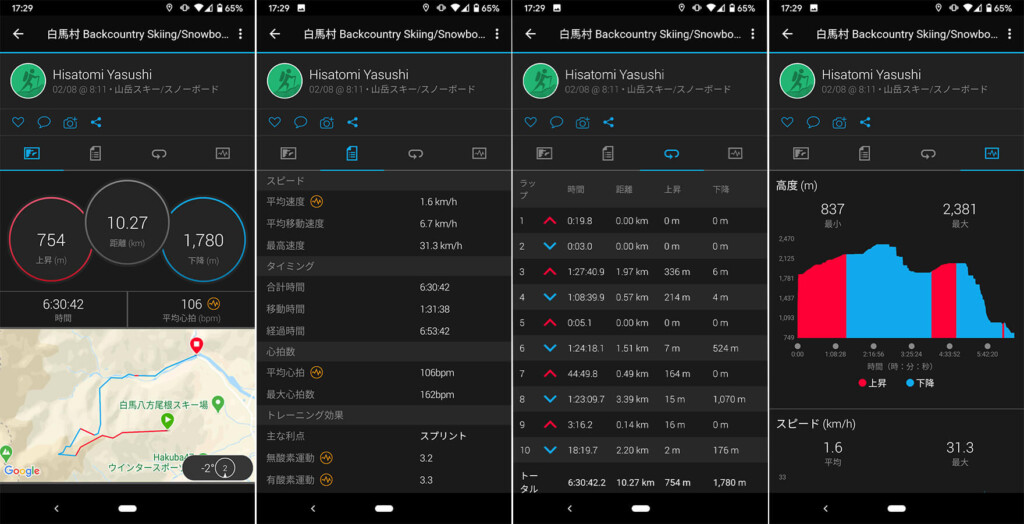
For running or trail running
For running activities, you can analyze running dynamics such as pitch and stride, as well as speed and pace.

As always, the apps are excellent, with an interface that is easy to view detailed data. Not only can you understand detailed data on past activities, but you can also see all your daily activities and health status, including heart rate, steps, exercise, fatigue, stress, calories burned, and sleep quality and quantity. Its precision and ease of display are better than any other app in my personal opinion.
You can graphically view a variety of measurement data that are essential for detailed and multifaceted analysis of performance, including pitch, cadence (strajectory), VO2Max (maximum oxygen uptake), FTP (functional effective power), and lactic acid threshold. This will be an even more motivation for serious runners.

From left to right: Current dashboard, most recent activity, Vo2Max history, heart rate history. The display method is easy to understand with a suitable display method for each number.
Summary: What kind of people do they recommend?
Even after writing this much, it is hard to say that I have just written all the functions of this watch. This is an incredibly complete smartwatch packed with so many functions that a single person can master, but allows users to get a satisfying performance no matter what type of user you use, such as running, mountain climbing, and skiing. Even if someone who has been using a normal watch starts using it, I think it will be able to enter your smartwatch smoothly without any stress. There's not much dissatisfaction.
I felt that it has surpassed the ease of use, high functionality and good balance in everything from any manufacturer. If you're an outdoor enthusiast with a budget, don't hesitate to recommend it. However, when asked if someone who owns a Fenix 5x Plus would recommend replacing it, this time it's a bit unclear. Although everything has evolved evenly, the difference is a small difference. If you're looking for a Fenix 5x, you might need to buy a new one.
On the other hand, just because you pay a lot of money doesn't mean you're a watch that will do anything and do anything. To be honest, if you try to use it lightly with a half-hearted attitude, you will first be overwhelmed by the complexity of the operation, and then the enormous amount of things you can do, and in the end you will end up "I can't use it well." It keeps track of the quality and quantity of activities and sleep in everyday life, making it a convenient companion for maintaining your health, but if that's all, the Apple Watch will surely be enough.
In that sense, it will undoubtedly face the desires of outdoor addicts who want to "severe athletes" or "enjoy a variety of outdoor activities to the fullest, not limited to activities." For those of you who are finally thinking about buying a smartwatch as you head towards the new season. Everything is ready. All you have to do is jump in.
Official online store page for Garmin Fenix 6X Pro Dual Power



 Review: Garmin MARQ Expedition The unique pleasure that resides in Garmin's finest outdoor smartwatch, which cannot be measured by specs alone.
Review: Garmin MARQ Expedition The unique pleasure that resides in Garmin's finest outdoor smartwatch, which cannot be measured by specs alone.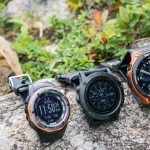 Purchase Guide: After trying out all CASIO, GARMIN, and EPSON, we found out the best solution for outdoor watches with GPS for each purpose [Part 1]
Purchase Guide: After trying out all CASIO, GARMIN, and EPSON, we found out the best solution for outdoor watches with GPS for each purpose [Part 1]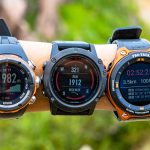 Purchase Guide: After trying out all CASIO, GARMIN, and EPSON, we found out the best solution for outdoor watches with GPS for each purpose [Part 2]
Purchase Guide: After trying out all CASIO, GARMIN, and EPSON, we found out the best solution for outdoor watches with GPS for each purpose [Part 2] Fenix HM62-T Review: Maximum light intensity of 1200 lumens! Outdoor headlamps that combine excellent performance and toughness
Fenix HM62-T Review: Maximum light intensity of 1200 lumens! Outdoor headlamps that combine excellent performance and toughness